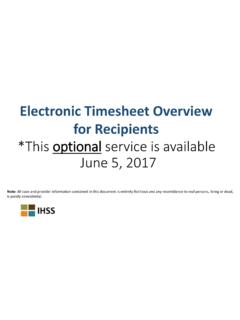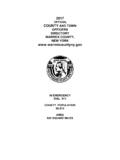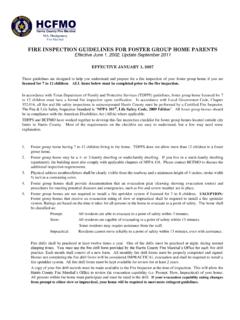Transcription of ACCESSING ASSISTIVE TECHNOLOGY - Pasc
1 ACCESSING ASSISTIVE TECHNOLOGY Chapter 17 Resource Guide (With Table of Contents) From a 17-Chapter Manual Available by Chapter and in Manual Form Third Edition, 2007 Written by: DISABILITY RIGHTS CALIFORNIA Copyright 1995 by Disability Rights California Prepared with funding provided through State Grants for Protection and Advocacy Related to ASSISTIVE TECHNOLOGY Program supported by funds from the Rehabilitation services Administration, Dept. of Education, Grant # H343A070005B. These materials are based on the laws and court decisions in effect at the time of publication. Federal and state law can change at any time.
2 If there is any question about the continued validity of any information in this manual, contact Disability Rights California or a legal resource in your community. (Blank Page) DISABILITY RIGHTS CALIFORNIA, is a private, nonprofit organization that protects the legal, civil, and service rights of Californians who have disabilities. Disability Rights California provides a variety of advocacy services , including information and referral, technical assistance, and direct representation. For information or assistance with an immediate problem, call: DISABILITY RIGHTS CALIFORNIA Toll Free: (800) 776-5746 8:30 AM to 5:00 PM - Monday through Friday Central Office 100 Howe Ave.
3 , Suite 185-N Sacramento, CA 95825 Legal Unit - (916) 488-9950 Administration - (916) 488-9955 TTY (800) 719-5798 San Diego Area Office 1111 Sixth Ave., Suite 200 San Diego CA 92101 (619) 239-7681 TTY (800) 576-9269 Los Angeles Area Office 3580 Wilshire Blvd., Suite 902 Los Angeles, CA 90010 Tel. - (213) 427-8747 TTY - (800) 781-5456 Oakland Area Office 1330 Broadway, Suite 500 Oakland, CA 94612 Tel. - (510) 267-1200 TTY (800) 649-0154 Disability Rights California receives funding under the Developmentally Disabled Assistance and Bill of Rights Act, the Protection and Advocacy for Mentally Ill Individuals Act, the Protection and Advocacy for Individual Rights Act, and the ASSISTIVE TECHNOLOGY Act of 1998.
4 Any opinions, findings, recommendations or conclusions expressed in this publication are those of the authors and do not necessarily reflect the views of the organizations which fund Disability Rights California. Chapter 17-ii ACCESSING ASSISTIVE TECHNOLOGY TABLE OF CONTENTS Chapter 1 Introduction and Overview Chapter 2 Advocacy Skills Chapter 3 Private Health Benefit Plans Chapter 4 Regional Centers Chapter 5 California Children's services Chapter 6 Reasonable Accommodation in Employment Chapter 7 Vocational Rehabilitation (Including Loan Programs) Chapter 8 Social Security Work Incentives Chapter 9 Special Education Chapter 10 Medi-Cal Chapter 11 Medicare Chapter 12 Veterans Administration Chapter 13 Right to ASSISTIVE TECHNOLOGY from Public Entities Chapter 14 Right to ASSISTIVE TECHNOLOGY from Private Businesses Chapter 15 Right to ASSISTIVE TECHNOLOGY in Higher Education Chapter 16 The Protections of The Lemon Law for Buyers of ASSISTIVE TECHNOLOGY Chapter 17 Resource Guide (with Table of Contents)
5 Acronyms & Abreviations Glossary Chapter 17-iii ACCESSING ASSISTIVE TECHNOLOGY Chapter 17 RESOURCE GUIDE Table of Contents Question Page 1 ASSISTIVE TECHNOLOGY SERVICE PROVIDER LIST .. 3 INDEPENDENT LIVING CENTERS .. 18 REGIONAL CENTERS .. 24 HIGH-TECH CENTERS FOR THE 28 SPECIALIZED services .. 29 VEHICLE MODIFICATIONS .. 31 SPECIAL services FOR PERSONS WITH HEARING IMPAIRMENTS .. 34 SOURCES OF PROCUREMENT ASSISTIVE LISTENING 35 PROFESSIONAL AND INTERDISCIPLINARY 37 ORGANIZATIONS.
6 38 ADVOCACY RESOURCE 41 HEALTH INSURANCE COUNSELING and ADVOCACY PROGRAM HICAP .. 45 PUBLICATIONS .. 46 Chapter 17-iv Chapter 17-v (Blank Page) Chapter 17 RESOURCE GUIDE INTRODUCTION This ASSISTIVE TECHNOLOGY Resource Guide is presented to make information available to persons with disabilities, health professionals, employers and other interested individuals to help identify and locate ASSISTIVE technological equipment and devices. These devices and equipment can enable persons with disabilities to more effectively work, learn and access community services and resources. The inclusion of any organization or product in the guide does not indicate or imply official endorsement of approval of such organization or product by the California ASSISTIVE TECHNOLOGY System or the State of California.
7 In considering the application of ASSISTIVE TECHNOLOGY , there are three important principles which must be stressed: The importance of a thorough evaluation, the team approach and consumer involvement. Evaluation: In most cases an evaluation of the device or equipment should be carried out by professionals in the field related to the TECHNOLOGY involved. For example, there are many types of aids for persons with visual impairments, including special glasses, closed-circuit TV cameras which enlarge print, and talking computer terminals. They all have certain advantages and drawbacks and should be appropriately evaluated for each user to make sure they match his/her needs.
8 In some cases, the selection of inappropriate equipment can even aggravate the user's impairment. The Team approach: Ideally, the evaluation should be carried out by a team of professionals with the active involvement of the consumer. Depending on the TECHNOLOGY involved, the evaluation team can be composed of individuals from various disciplines, such as an occupational therapist, physical therapist, physician, rehabilitation counselor, equipment vendor, computer expert, and others. The key to any team's success is the active involvement of the consumer. Consumer Involvement: It is the consumer who will have to adapt to and live with the TECHNOLOGY ( , device, equipment, computer software) after a determination is made by the evaluation team.
9 Therefore, it is crucial that he/she play as active a role as is possible. The consumer must, as much as possible, let the evaluation team know what the purpose of TECHNOLOGY is ( , independent living, Chapter 17-1 working or transportation). During the evaluation, the consumer must advise the team of any problem or discomfort in using the recommended TECHNOLOGY . The consumer must also ensure the device or equipment is adequately maintained after obtaining it. The important component of any ASSISTIVE - TECHNOLOGY system is the user. Chapter 17-2 ASSISTIVE TECHNOLOGY SERVICE PROVIDER LIST The following programs can provide assessment and recommendations of ASSISTIVE devices.
10 They are listed geographically. (Once again, we emphasize the importance of individuals obtaining a thorough evaluation.) Northern California and Central Valley Name: Mercy Outpatient Rehabilitation Center Address: 406 Sunrise Ave., Suite 300 Roseville, CA 95661 Phone: (916) 536-2425 Contact: Margaret Keeling services : Seating and wheeled mobility evaluations, home and worksite evaluations, work capacity and physical capacity evaluation. Name: Department of Rehabilitation Client Assistance Program (CAP) Address: Offices throughout the State. Check phone book for listing.








